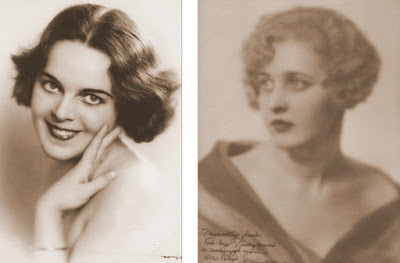 |
| Miss Judea - Zofja Ołdakówna on the cover of the Film magazine |
 |
| Zofja Ołdakówna and the zionist group at Grochów kibutz in Warszawa preparing for the Eretz Israel. |
 |
| Miss Judea - Zofja Ołdakówna |
 |
The winner of the pageant Miss Judea was 19-year-old miss Zofja Ołdakówna, who applied under the pseudonymJudyta. |
Zofia Oldak (Zofja Ołdakówna) was the winner of the Miss Judea Beauty Contest in Warsaw year 1929. She was the first and the last Miss Judea.
The contest to crown the most beautiful Jewess in Poland was sponsored by Warsaw’s Polish-language Jewish daily newspaper Nasz Przeglad (Our Review). Hundreds of young women from all over Poland entered the contest by sending their photos to the Nasz Przeglad offices. First, the readers narrowed the contestants down to a top-10 group, and then a panel of “experts” crowned Judyta (Zofia Oldak - Zofja Oldakówna) winner.
On February 3rd 1929, the editors of Warsaw's Jewish daily newspaper Nasz Przeglad announced the upcoming beauty pageant to find Poland's most beautiful Jewess. The ideal candidate would embody, so the newspaper declared, the "characteristic features of the Polish Jewish female type".
131 women entered the competition for six weeks, of whom eleven made it into the finals. Only one bright-eyed blonde contestant was found among the finalists - Miss Roma Gliksman. In an interview before the final judging at Hotel Polonia at Marshall Street started, miss Gliksman expressed her feeling of disadvantage on account of her apparent physical shortcomings. The pageant winner was 19-year-old Miss Zofja Ołdakówna, who applied under the pseudonym Judyta. She was described by the jury as bearing the perfect physical hallmarks of the "Jewish race" and noted for her "Sephardi looks." However, in a poll, the newspaper ran among its readers Oldakówna was only ranked in the sixth place, with only 10,205 votes in her favor. The readers, who were instructed to choose the candidate best delineating ethnic Jewish beauty, favored Miss Marja Łobzowska.
Miss Judea was after crowning visiting hospitals, orphanages, and official institutions. She also visited Janusz Korczaks Orphanage.
It is most likely that most of the contestants were murdered during the Holocaust. Judyta (Zofia Oldak) was like most of the Warsaw Jews deported to the death camp Treblinka.
 |
| The first Poland elections of Miss Polonia started in late 1928. Miss was chosen only based on the sent photographs. |
%20=%20nr%2052%20-%201%20-%2003087eeb-b971-46d6-84e9-e6f702400e56.jpg) |
| The first Poland elections of Miss Polonia started in late 1928. Miss was chosen only based on the sent photographs. Here Benedykt Rotenberg/Dorys photo in EWA, February 10th, 1929. |
 |
| The first Poland elections of Miss Polonia started in late 1928. Miss was chosen only based on sent photographs. Here Benedykt Rotenberg/Dorys photo in EWA, February 10th, 1929. |
The first Poland elections of Miss Polonia started in late 1928. Miss was chosen only based on the sent photographs. The first winner of Miss Polonia was announced on January 27, 1929, Władysława Kostakówna a modest worker of the Municipal Savings Bank in Warsaw. She defeated her high-born rivals: Alina Ryszczewska and Hanna Daszyńska. The photos of the first (and also second) Miss Polonia were taken te Jewish photographer Benedykt Rotenberg, known as Dorys.
The same year Rotenberg took photographs of future Miss Polonia he visited Korczak's summer camp Rózyczka and took some photographs there. What connected Benedykt Rotenberg and Janusz Korczak? Why did he come after a colony in 1928? In 1928, Rotenberg opened his own studio "Photo Dorys" at 41 Aleje Jerozolimich, the corner of Poznańska Street. Rotenberg's breakthroughs were two in a row Miss Polonia's 1929 and 1930 photographs.
Rotenberg/Dorys ran his studio at 41 Aleje Jerozolimskie (corner 39 Poznanska str - the building survived WWII) until 1939. He was then forced to sell it and along with thousands of other people, like Korczak, he had to move to the ghetto. There, he continued his photography business at 16 Chlodna Street. He also had Germans coming to his small studio. They would often ask him to develop negatives: many were shots of the ghetto. Dorys made copies and passed them on to underground organizations.
The same year Rotenberg took photographs of future Miss Polonia he visited Korczak's summer camp Rózyczka and took some photographs there. What connected Benedykt Rotenberg and Janusz Korczak? Why did he come after a colony in 1928? In 1928, Rotenberg opened his own studio "Photo Dorys" at 41 Aleje Jerozolimich, the corner of Poznańska Street. Rotenberg's breakthroughs were two in a row Miss Polonia's 1929 and 1930 photographs.
Rotenberg/Dorys ran his studio at 41 Aleje Jerozolimskie (corner 39 Poznanska str - the building survived WWII) until 1939. He was then forced to sell it and along with thousands of other people, like Korczak, he had to move to the ghetto. There, he continued his photography business at 16 Chlodna Street. He also had Germans coming to his small studio. They would often ask him to develop negatives: many were shots of the ghetto. Dorys made copies and passed them on to underground organizations.












